
31% of TV ads feature celebrities in China, however, using a celebrity does not guarantee effective advertising. Celebrity-based campaigns can be very effective. The Snickers “You’re not you when you’re hungry” campaign won a Cannes Lion Creative Effectiveness award.
Celebrities are used in advertising around the world. The right celebrity, used in the right way, can undoubtedly be a powerful brand asset. But using a celebrity does not guarantee effective advertising; overall, there’s very little difference between the performance of ads with celebrities versus those without. However, celebrities can make campaigns more effective.
There are pitfalls to using celebrities. To gauge whether a celebrity is right for your brand, you need to establish whether they are known, whether they are liked, and what they stand for, among your target audience. Here is a data-based guide to help you understand the pros and cons of using celebrities in your campaigns.
WHERE ARE CELEBRITIES USED IN ADVERTISING?
The use of celebrities in advertising varies enormously around the world. It continues to be highest in the Asia Pacific, as this analysis of ads we have researched with our Link copy test shows.
In terms of individual countries, use is highest in Japan and Korea, where around 40% of TV ads feature celebrities; and lowest in Norway, Austria, Croatia, Kazakhstan, El Salvador and Costa Rica, where the proportion is under 3%. It is 31% in China, 23% in India, 11% in the United States, and 11% in the United Kingdom.
While celebrities are less likely to be used for medical ads, there is little other patterns of celebrity use by category, as this comparison of India, China, US, and UK data shows.
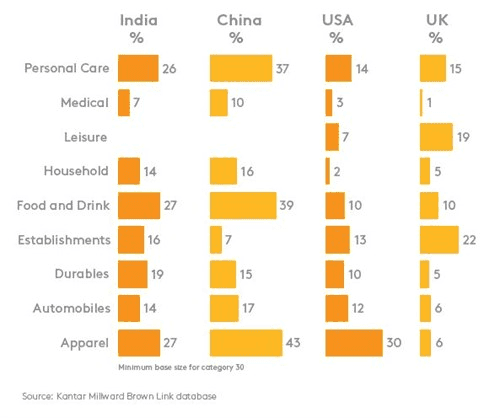
ARE THEY EFFECTIVE?
Celebrity-based campaigns can be very effective. The Snickers “You’re not you when you’re hungry” campaign won a Cannes Lion Creative Effectiveness award.
Snickers’ ad featuring Mr. Bean
However, while individual celebrity campaigns can be highly effective, there is very little difference overall between the performance on most key measures of individual ads with celebrities versus those without; as illustrated by the analysis of ad enjoyment opposite.
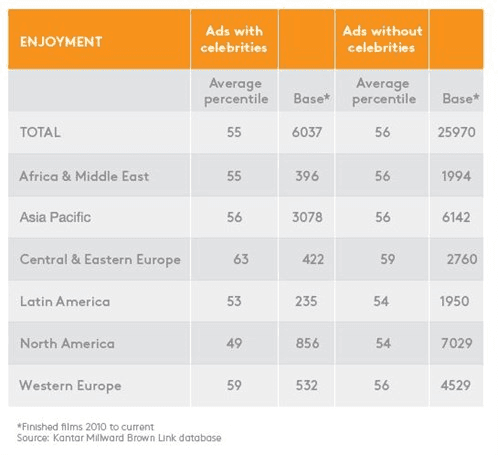
This includes other key measures too. Some regions, notably the US, and Central and Eastern Europe, find celebrity ads slightly more involving; but in other regions, particularly where celebrity ads are more common, this is not the case. Overall, branding levels tend to be similar.
However, our CrossMedia database suggests that campaigns with celebrities tend to be more effective than campaigns without.
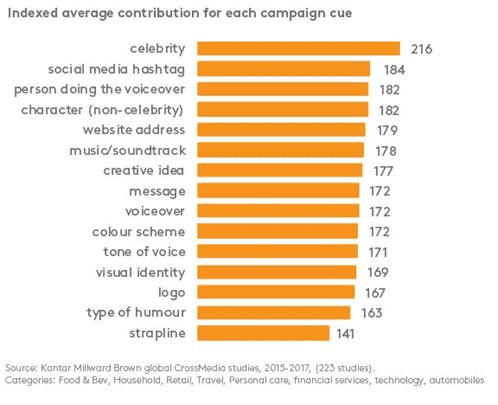
Why should this be? An internal assessment of the campaigns for the 2018 AdReaction study suggested that campaigns with celebrities tend to be better integrated. It seems the presence of a celebrity can provide an instant link to other elements of the campaign, promoting synergy. But other audio and visual elements can also provide that “instant link”.

For some long running campaigns, particular celebrities have, over time, become synonymous with the brand. The following example shows the gradual build of one celebrity brand cue over 15 ads. Kantar Millward Brown recruited non-repetitive sample audiences to watch one of these ads during this period of time. In the long run, the celebrity brand cue had risen from 5% to 81%.
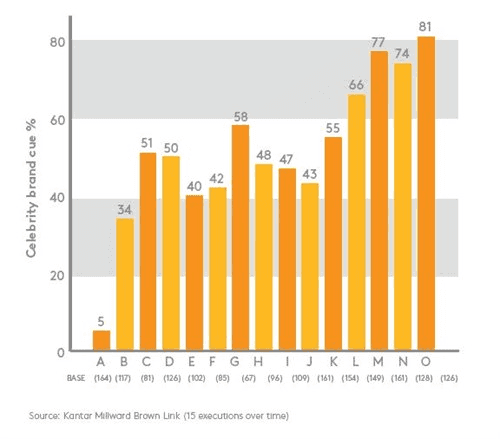
In Japan, however, branding scores are slightly lower for ads with celebrities — possibly due to the celebrities endorsing too many brands.
THREE KEY QUESTIONS FOR EFFECTIVE USE OF CELEBRITIES
Given that using a celebrity does not guarantee a successful campaign, what are the guidelines for getting it right? We’d suggest there are three key questions you need to answer.
Who is the celebrity?
Where the celebrity is central to the core idea, it’s important to establish how well known they are among your target audience. In the US, a lipstick brand was launched using a British model. Among those who recognized her, communication, enjoyment and purchase intent were much stronger. However, less than a quarter of the audience recognized her, severely limiting the effectiveness of the campaign.
Overall, the effect of the fame of the celebrities differs by country: for instance, in the US and UK, well-known celebrities can help slightly with Branding. However, in China (Shanghai) there is little difference in key measures whether the celebrity is well recognized or not.
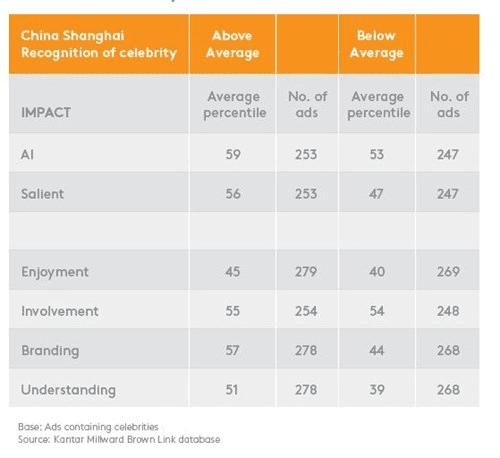
Is the celebrity well liked?
While it isn’t essential for a celebrity to be liked, this can have a significant impact on the emotional response to an ad.
The effectiveness of likable celebrities is more similar across countries: enjoyment is higher when the celebrity is liked, in all countries. In the US, UK, China, and India salience are also higher. Branding is higher in India, Russia and the UK when the celebrity is liked, and understanding in the US and India. All countries tend to see higher scores across persuasive measures and overall Power Contribution when the celebrity is liked.
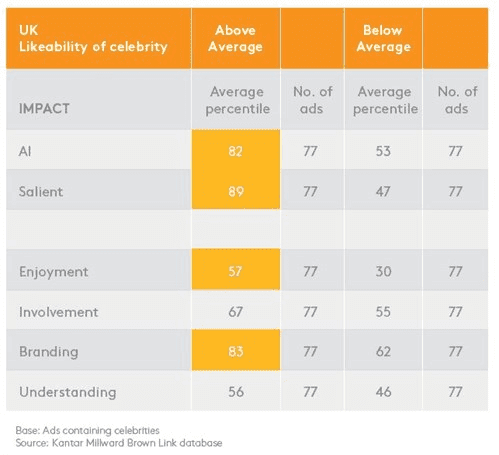
In particular, the likability of the celebrity needs to be assessed among the target audience. In one project for a cereal brand in the UK Millward Brown asked about celebrities who were considered positive role models. One particular male TV and radio presenter was rated highly, but this ranking was driven by the 40+ age group. When we researched an animatic version of an ad for the brand featuring him, he was dismissed by the younger target respondents as being too old and old-fashioned. In the ad he played with a younger woman’s hair; a scene which respondents found disturbing and uncomfortable. The ad was not produced.
What does the celebrity represent?
It’s important to understand how well the celebrity fits with the brand, or with where you want to take the brand. When the celebrity is perceived to be appropriate, communication can be enhanced.
The “right fit” celebrity can enhance key measures; take celebrity ads we’ve researched in Shanghai as an example:
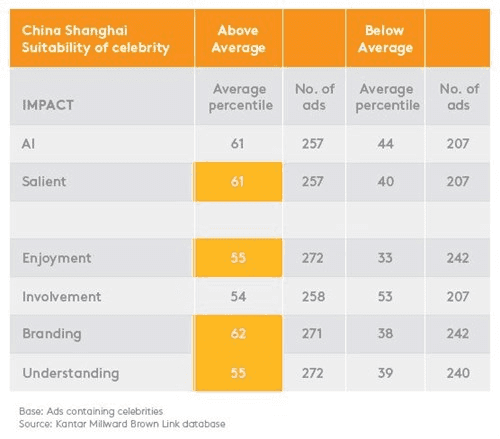
Potential pitfalls
Unlike an animated character, celebrities are human and subject to human failings. So there are a number of ways in which a celebrity could become a liability to the brand.
Examples of celebrity activities potentially damaging a brand include: OJ Simpson, the face of Hertz, being charged with murdering his ex-wife, Nicole Brown Simpson; Whoopi Goldberg, failing to lose weight while endorsing Slim-Fast; following the media exposure of his adulterous affairs, and a public divorce from his wife, Tiger Woods lost five major endorsements. Brands are quick to distance themselves from such issues. In early 2016, when Maria Sharapova failed a drugs test, brands she had promoted such as Nike, Tag Heuer, and Porsche all distanced themselves from her within 24 hours.
In addition, there is always the risk of a celebrity becoming the hero of an ad, rather than the brand. A new campaign was developed for a tea brand in India, featuring popular movie actors. Millward Brown researched two versions of the ads in animatic forms; one with the celebrities, and one without. The research showed that, in the versions with the celebrities, the message takeout was weaker; the celebrities were ‘drowning out’ the communication. And while the celebrities were intended to help gain attention, the versions without celebrities were just as impactful. The client went ahead and filmed and aired versions without celebrities.
However, the right celebrity, used in the right way, can be a powerful brand asset; in any country, in any category.
So to summarize, before you sign a celebrity to feature in your ads, please go through this checklist and make sure you have the right answers for all of them:
- Is the celebrity well known?
- Do my targeted audience like this celebrity?
- What does this celebrity represent?
- Do I have a damage control plan if the celebrity makes some mistake?
- Will my ad make people remember my brand or the celebrity?
Check out China’s mobile advertising market or compare the two popular short-video mobile apps
This article was originally published on Kantar.com